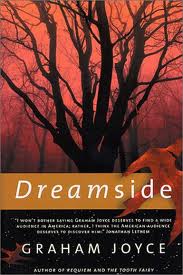This is an article I wrote with Tracey Kahan, Professor of Psychology at Santa Clara University in Santa Clara, California that examines the dream journals of twenty-one college students in the fall of 2001 for evidence of influences from the terrorist attacks of 9/11.
Review of “Dreaming in the World’s Religions”
Here is a review of my book in the journal History of Religions, August 2010, volume 50, number 1, pp. 107-108, by Kimberley C. Patton of Harvard Divinity School.
History of Religions review of “Dreaming in the World’s Religions”
Seeking Patterns in Dream Content: A Systematic Approach to Word Searches
A Lucid Dreaming Cautionary Tale: Graham Joyce’s “Dreamside”
 Later this month (3-23) I’m joining British novelist Graham Joyce at the Rubin Museum in New York City to discuss “Are Dreams Pure Fantasy?” as part of the museum’s “Brainwave” lecture series on dreams. I’ve just read Joyce’s first novel, Dreamside, and it’s a hauntingly beautiful tale, both frightening and inspiring. It raises vital questions about the perils and potentials of lucid dreaming.
Later this month (3-23) I’m joining British novelist Graham Joyce at the Rubin Museum in New York City to discuss “Are Dreams Pure Fantasy?” as part of the museum’s “Brainwave” lecture series on dreams. I’ve just read Joyce’s first novel, Dreamside, and it’s a hauntingly beautiful tale, both frightening and inspiring. It raises vital questions about the perils and potentials of lucid dreaming.
Written in 1991, the novel accurately conveys the naïve excitement many people felt at that time about early psychological research on consciousness in dreaming. The story concerns four college students who sign up for a study on the induction of lucid dreams. The students form an unlikely team, each driven by very different motives. Ella, a mercurial, sexually alluring spiritual seeker, will do and say anything to achieve transcendence. Lee, the central character, is a stolid, rather conventional guy painfully captivated by Ella’s erotic energy. Brad, a medical student, has the most advanced innate skills at lucid dreaming, but he’s a cynical, drunken lout who can only express his sexual desires in the crudest of ways. Honora, from Ireland, is the quietest and most innocent of the group. Of them all, she is the most sincere in her desire to learn about dreaming.
Their guide from waking reality into Dreamside is Professor Burns, an elderly psychologist with a hobbyist’s interest in parapsychology and an ornery disregard for other people’s feelings. Initially the lucid dream induction seminar is just a sham, as the Professor is in fact conducting a study of small group dynamics. But when the students begin succeeding in their efforts—when they learn how to become aware in dreams, interact with each other, and perform various experiments to test their Dreamside abilities—Prof. Burns becomes excited, too, and pushes them further and further.
Without revealing any other plot developments, it may simply be said that everyone involved reaches a point where they deeply regret their blind rush into alien realms of psychic experience.
The moral of the story is not that lucid dreaming is bad. Nor is it that Prof. Burns might have benefited from the input of a human subjects committee, though that’s undoubtedly true. It’s rather that we need to ask the right questions about lucid dreaming. The characters in Dreamside are so intent on figuring out how to induce lucid dreaming that they never ask themselves why they want to do so in the first place. The “how” question is relatively easy, but if you haven’t reflected carefully on the “why” question you may find yourself woefully unprepared for what you encounter.
This is the same message that Hindu and Buddhist sages have taught for centuries: it is indeed possible to learn lucid dreaming techniques, but those techniques are best practiced within a context of spiritual training, guidance, and self-reflection. The college students in Dreamside have grown up in the morally impoverished world of Thatcher-era Britain, and they have few cultural resources to help them make sense of their experiences. Perhaps the greatest achievement of Joyce’s novel is that it provides what its characters lack—a wise and healthily cautious understanding of human dreaming potential.
Religious and Non-Religious People: A Survey of their Dreams
 People who are not Christian and not religiously observant report higher dream recall and a higher frequency of most typical dreams. That’s one of the initial findings from a study I’m doing on the demographics of dreaming, based on survey results from 2992 American adults. Most religious traditions regard dreams as spiritually significant. But the people who are most engaged with their dreams in present-day America tend to be those who are not affiliated with mainstream Christianity and who rarely or never attend worship services.
People who are not Christian and not religiously observant report higher dream recall and a higher frequency of most typical dreams. That’s one of the initial findings from a study I’m doing on the demographics of dreaming, based on survey results from 2992 American adults. Most religious traditions regard dreams as spiritually significant. But the people who are most engaged with their dreams in present-day America tend to be those who are not affiliated with mainstream Christianity and who rarely or never attend worship services.
Compared to Protestant and Catholic Christians, people who answered “Other/None” to the question of their religious affiliation reported the highest frequency of dreams of chasing, sexuality, falling, flying, and being able to control their dreams. Similarly, people who never attend religious worship services have higher dream recall and higher frequencies of many types of dreams as compared to people who attend worship services once a week or more. These findings are consistent with the results presented in chapter 3 of my 2008 book American Dreamers:
“Non-religious people report more of every type of dream, especially sexual dreams.” (91)
That finding came from a survey in 2007 of 705 American adults. The appearance of the same pattern in the 2010 survey suggests the correlation may be worth pursuing for the new light it can shed on the psychology of religion.
The new survey has the advantage of including narrative dream reports from many of the participants. I’m just beginning to sift through this data using word searches and other methods of analysis.
Here are a couple of short nightmares from the “Other/None” people who never attend worship services:
“I often have nightmares about spaceships, or unknown forces coming across a horizon, often with a sense of impending doom. The anticipation of death lasts and lasts and lasts…eventually i wake up.”
“I was being chased by a huge blob monster that looked like purple jello. I shot it with a rifle, but it broke up into several monsters. I ran into a house that looked like a Disney castle, and it swallowed the house.”
Here are two from Born-again Christians:
“I was falling in a fast freefall with no end in sight and as I went further I know I was trying to scream but only a low gutteral sound was coming out. I heard myself make that noise and sat up sweating and scared.”
Dreams in A Midsummer Night’s Dream
 A dream researcher friend asked if knew anything about the role of dreams in Shakespeare’s romantic comedy “A Midsummer Night’s Dream,” since she could not find any good info on the web. Here’s my response, which she suggested I post:
A dream researcher friend asked if knew anything about the role of dreams in Shakespeare’s romantic comedy “A Midsummer Night’s Dream,” since she could not find any good info on the web. Here’s my response, which she suggested I post:
One way to think of this play is as a commentary on the glorious folly of love. Shakespeare is saying that love is like a dream—it radically changes our perception of reality and other people, it compels us to behave in ways that are foolish and irrational, it’s wild and magical and unpredictable, and it ultimately must yield to the sovereignty of the waking social order (as the end of the play makes clear).
After Bottom has returned from donkey to human status he says some funny things about how crazy and unbelievable dreams are, which is extra amusing and paradoxical because we in the audience have just seen that his “dream” of being an ass was indeed real (IV.ii.203-222).
One of the young lovers, Hermia, has an alarming dream about her beloved Lysander smiling cruelly while a serpent bites her breast (II.ii.144-150). Her dream turns out to be an accurate “threat simulation” reflecting Lysander’s sudden change of heart towards her.
When all the lovers awaken toward the end, they marvel at their strange nocturnal experiences, and say some nice things about sharing dreams with each other (IV.ii.189-202).
Add to this the fact that the play was originally intended to be performed on midsummer’s night, traditionally a “dreamy” celebration of the shortest night of the year, when people stay up and carouse about till dawn.
And in the final lines of the play, the mischievous Puck asks the audience to pretend they’ve been asleep the whole time, dreaming the spectacle before them (V.i.429-430).
All in all, it’s a play that emphasizes the powerful emotional truth of dreaming and the energizing tension between dream desire and waking structure.
Thanks to Justina Lasley of the Institute for Dream Studies!
